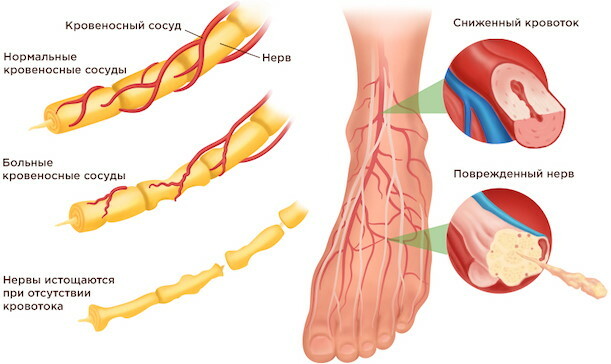Content
- Possible reasons
- Peripheral neuropathies
- Diseases of the brain and spine
- Spinal Cord Disorders
- Circulatory disorders
- Toxin poisoning
- Treatment methods
- Drug treatment
- Other forms of therapy
- Surgery
- Home remedies
- Potential consequences and complications
- Video about numbness of hands and feet
Partial or complete loss of sensitivity can occur anywhere on the body. This happens more often when a person is in an uncomfortable position for too long. In this case, the hand, leg on the right or left side go numb individually or at the same time. But these symptoms usually disappear when the weight is removed from the numb body parts and the normal blood supply is restored.
Possible reasons
Loss of sensation in one arm and leg usually indicates a problem with the nerve in the affected limb. However, when both arms or legs are affected at the same time, it is most likely a nerve root problem or a systemic problem in which multiple nerves are affected.
The right arm and leg go numb at the same time - this is most often the result of pinched nerves both in the spine and in the joint itself.
This can sometimes be a sign of a serious problem, especially if the symptoms last for a long time.
Peripheral neuropathies
They are a group of diseases that affect the nerves outside the brain and spinal cord (periphery is the outer surface, neuropathy is a nervous disease).
Sensory, motor, autonomic fibers of the spinal nerves and vagus nerve can be affected and cause:
- Numbness, tingling, burning, pain, or weakness in the limbs.
- Coordination problems, muscle weakness, partial paralysis, falls due to leg flexion, problems with toe mobility.
- Difficulty breathing or swallowing.
- Dizziness on rising.
- Early satiety, diarrhea, constipation, unintentional weight loss.
- Problems with urination.

Right arm and leg go numb
Some of the possible causes of peripheral neuropathies leading to numbness in the arms, legs, or tingling sensations are common symptoms:
- Diabetic peripheral neuropathy (in type 1 or type 2 diabetes mellitus) causes numbness in the "stockings-gloves" type (feet-hands).
- Alcoholic neuropathy with prolonged excessive consumption of alcoholic beverages. This adds a burning sensation in the legs, a wide gait.
- Rheumatoid arthritis. Symmetrically swollen and warm joints of the hands and feet, morning stiffness, numbness are observed.
- Vitamin B 12 deficiency. There is weakness due to anemia, pallor, painful sensations in the mouth and tongue, loss of appetite, numbness of the feet and hands.
- Uremia (from kidney failure). Weakness, uremic frost, itchy skin (all over the body), puffy face in the morning, numbness in the limbs, odor of urine from the mouth.
- Lyme disease. Severe fatigue and headache, changes in behavior, numbness in the limbs, problems with the eyes, heart or joints.
- Hepatitis C. History of drug abuse, limb numbness.
- Chronic inflammatory demyelinating polyneuropathy (CIDP) is inflammation of the peripheral nerves due to an abnormal immune response. Numbness or tingling usually begins in the fingers or toes, weakness in the hands and feet appears, and fatigue becomes common.
- Amyloidosis. Enlarged tongue, overflow of the right upper abdomen, numbness of the arms, legs.
Diseases of the brain and spine
The right arm and leg go numb at the same time - this syndrome can be caused by various diseases of the central nervous system (CNS), including the brain and spinal cord.
- Multiple sclerosis can cause numbness and tingling in various parts of the body, but rarely symmetrically.

- With a stroke, sudden numbness develops on one side of the body, such as the right arm and leg.
- Curvature of the spine contributes to numbness.
Spinal Cord Disorders
Spinal conditions causing numbness and tingling in the hands and feet:
- Injury to the cervical spine leads to numbness, arms, legs and paralysis. Injuries at the thoracic level affect the trunk and legs, while injuries to the lower back and sacrum affect the thighs and legs.
- Spinal tumors. Symptoms depend on their location and include pain in the back, arms, or legs, weakness, numbness, partial paralysis, clumsiness, muscle cramps, bowel problems, bladder problems, or deformity spine. Symptoms can develop gradually or suddenly.
- Syringomyelia is a cyst of the spinal cord. Symptoms include pain, numbness, and stiffness in the back, upper torso, arms, and legs.
- Spinal arachnoid cysts are cysts around the spinal cord that contain cerebrospinal fluid. Symptoms: Back and leg pain, tingling or numbness in the legs or arms that get worse over time.
Circulatory disorders
Limbs grow numb at the same time, for example, the right arm, leg, and in case of circulatory disorders.
- Peripheral artery disease is narrowing of the arteries due to calcification (arteriosclerosis). The affected legs or arms may be pale, cold, with painful tingling or numbness.
- Burger's disease. It develops in heavy smokers and causes pain, numbness, and tingling in the feet and hands that occur with exercise and are relieved by rest.
- In Raynaud's disease, the arteries at the tips of the hands and feet suddenly narrow and restrict blood supply. It could be caused by a cold or stress, but the exact cause is unknown.

- Polyarteritis nodosa is a type of vasculitis that affects medium-sized arteries. In this case, painful changes in the skin on the legs, partial paralysis of the limbs, numbness of the arms, legs, fever and weight loss occur.
- Chronic necrotizing vasculitis is a rare vasculitis that affects the walls of the arteries and causes fever, red spots on the limbs, and numbness and tingling in the toes, feet, and hands.
Toxin poisoning
Contact with certain toxins can cause numbness in the legs and arms. Radiation therapy sometimes causes numbness in various parts of the body, including the right arm and leg. Toxins in seafood can also cause numbness in the hands if swallowed. Some insects, including ticks, spiders, when bitten, contribute to the numbness of the arms and legs when they bite through the body.
Treatment methods
Therapy includes both conservative and operative means (for example, for vascular diseases). In case of circulatory disorders, diabetes, multiple sclerosis, the underlying disease is treated. Orthopedic disorders, for example, osteochondrosis, disc herniation, are treated with an operative method (for example, decompression of the nerve root) or conservatively.
Numbness on one side of the body is not always a sign of a serious condition, but urgent medical attention is needed if other symptoms are present.
- Sudden numbness for no apparent reason.
- Rapid deterioration of the condition.
- Problems speaking or understanding other people.
- Omission of one side of the face.
- Blurry or double vision.
- Dizziness, loss of balance
- Fever, severe headache
- Chest pain, shortness of breath.
- Severe pain in an arm, leg, or foot that does not go away with rest.
- The arm and leg become cold, pale or blue, and difficult to move.
- The syndrome appeared after a neck or back injury.
Drug treatment
The right arm and leg go numb at the same time - this is a condition that can be treated with both home and medical remedies.
-
Spondylosis. Taking non-steroidal anti-inflammatory drugs (NSAIDs) or pain relievers can relieve pain. You can try to treat spondylosis by changing your posture, such as buying a more comfortable office chair to support your spine.

Lumbosacral spondylosis - Slipping disc. In most cases, a slipped disc will spontaneously shrink over time. Any pain is relieved when the disc stops pressing on the affected nerve. It usually takes 4 to 6 weeks to recover. Most people will need to do light exercise and take pain relievers and anti-inflammatories.
Treatment for sensory disturbances in the hands and feet depends on the cause, with the following treatment options being considered:
- In diabetes, optimal control of blood sugar, diabetic education is carried out.
- Treating infections, such as antibiotics if bacteria are the cause.
- Inflammatory conditions that cause numbness in the extremities are treated with cortisone tablets or topical injections.
- Vitamin B12 deficiency is compensated by supplementation.
- Refusal from alcohol addiction.
- Conventional pain relievers often do not help nerve pain. However, in many cases, relief can be achieved with medications that are used to treat depression (antidepressants) or seizures (antiepileptic drugs). In severe cases, the doctor will prescribe strong pain relievers (opioids).
To alleviate the painful symptoms caused by the disruption of the intervertebral disc, a number of medications are prescribed to relieve the condition.
| Analgesics | Paracetamol. The drug should be used with caution in people with liver, kidney problems or alcohol dependence. Unless otherwise indicated, take no more than 4 doses of paracetamol in 24 hours. |
| Non-steroidal anti-inflammatory drugs | NSAIDs like Ibuprofen, Diclofenac, and Naproxen can relieve pain and reduce inflammation. NSAIDs are not suitable for people with hypertension, asthma, heart or kidney failure. |
| Corticosteroids | These are medications containing hormones that are injected into the lower spine to reduce inflammation. |
| Muscle relaxants | Your doctor may prescribe a muscle relaxant, such as Diazepam, for several days if the muscles in your back or legs are very tense. |
To avoid back pain, which can contribute to numbness in the limbs, it is necessary to maintain mobility, exercise regularly, maintain good posture and lift heavy items.
- Regular exercise slows down the age-related deterioration of the intervertebral discs of the back, helps to keep the supporting muscles of the back elastic and strong.
- It is important to use the correct technique when lifting heavy weights.
- When sitting or driving for a long time, make sure the seat is comfortable and supports your back. Take regular breaks whenever possible to rest and stretch your muscles.
- Try to maintain good posture at all times.
- When sitting at a table, make sure that the height of the chair matches the height of the table. Keep your feet flat on the floor and knees bent at a 90˚ angle.
Other forms of therapy
If you feel numb, you can massage the affected limb to improve blood flow. Sometimes it helps to apply an ice pack to the affected area for 15 minutes, but be careful not to damage the skin. When you are numb, you may not notice whether your skin becomes too hot or cold.
Some alternative therapies, such as massage or acupuncture, can also help. If the numbness is caused by a vitamin deficiency, your doctor will advise you to take a supplement.
Surgery
Surgical measures are required, for example, in the case of injuries with injury, pinching of a nerve (herniated disc) or in the case of tumors.
Home remedies
The following procedures will help get rid of numbness, as well as improve sensitivity:
- Warm compress. This is one of the easiest ways to get rid of tingling sensations in your feet and hands. All you need to do is apply a warm heating pad to the affected part of your body. This will increase blood flow to the numbed area, which will help relax the nerves and muscles in that area.
- Epsom salt contains crystals of magnesium sulfate, which increase the level of magnesium in the body, which in turn helps to improve blood circulation. To do this, put your hands in a container of hot water containing Epsom salts for 10-15 minutes. Carry out the same procedure with the legs.
- Lavender oil and primrose effectively helps to get rid of numbness in the legs and arms, increasing blood circulation in the affected part. The body is massaged with oil for 20-25 minutes until relief comes.
Potential consequences and complications
The prognosis of numbness in the legs and arms is positive, but only if treatment is started on time. Often the cause of the symptom is normal fatigue. But in many cases, this indicates the presence of a serious illness.
If it is Raynaud's, delayed treatment may result in limited thumb movement.
Leaving the problem with the spine neglected is also not worth it. In the future, this will lead to a worsening of the situation. In some cases, surgery is required to eliminate the unpleasant symptom. Therefore, if the legs and arms are numb, you should immediately seek help.
Simultaneous loss of sensation in the right leg and arm is not always a negative diagnosis. More often this happens from fatigue and with the help of preventive measures and home remedies, you can get rid of the discomfort. But if the limbs become numb often, you should check for health problems.
Video about numbness of hands and feet
Causes of numbness in hands and feet:



